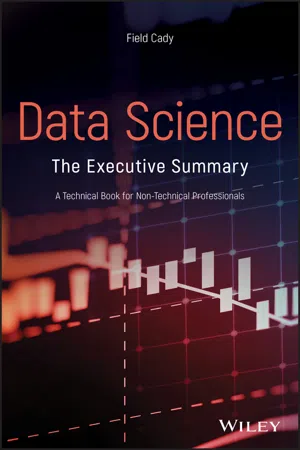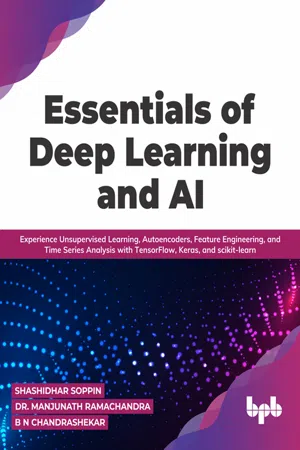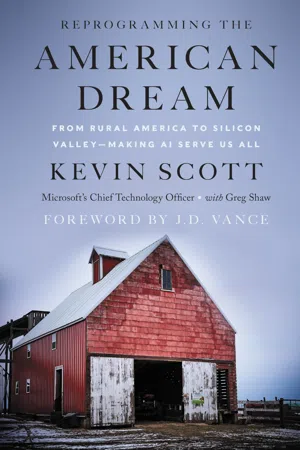Machine Learning Models
Machine learning models are algorithms that can learn from and make predictions or decisions based on data. These models are trained using large datasets and can be used for tasks such as classification, regression, clustering, and recommendation. They are a key component of artificial intelligence and are used in various applications such as image and speech recognition, medical diagnosis, and financial forecasting.
8 Key excerpts on "Machine Learning Models"
- eBook - ePub
Machine Learning for Risk Calculations
A Practitioner's View
- Ignacio Ruiz, Mariano Zeron(Authors)
- 2021(Publication Date)
- Wiley(Publisher)
...This was not just due to the simplicity of the models and the small number of people working with them but also to the fact that computers were only found in specialised research centres. As computers have become more powerful and ubiquitous — not only in a good number of industries but also as a tool for personal use — the range and number of applications has grown substantially. Nowadays, Machine Learning Models are used in a wide range of applications: in forecasting, such as in weather and stock market prediction; in anomaly detection, for example, fraud detection; for classification, for example, to identify patients with specific medical conditions; for ranking tasks, as search engines do when recommending websites; for summarising, for example, sentiment analysis in social media; for decision-making in robotics. And the list goes on. 1.1.2 Main sub-categories in Machine Learning As was mentioned in Section 1.1, ML consists of a set of models that automatically learn patterns from data and use these patterns to perform some task. These methods are typically divided into three sub-categories: supervised learning, unsupervised learning and reinforcement learning. Supervised learning Models and algorithms that fall into the category of supervised learning are those that learn from input and output data. Denote the input data by. This consists of a set of vectors, where each vector, for, lives in, for some. The variables in these vectors are typically called features or attributes of the set. They can be discrete or continuous. The output data, denoted by, consists of a set of vectors — typically real values — that represent a response or target variable. Again, this variable can be discrete or continuous. Each element in pairs up with. The data used to train the algorithm therefore consists of data points...
- eBook - ePub
Healthcare and Knowledge Management for Society 5.0
Trends, Issues, and Innovations
- Vineet Kansal, Raju Ranjan, Sapna Sinha, Rajdev Tiwari, Nilmini Wickramasinghe, Vineet Kansal, Raju Ranjan, Sapna Sinha, Rajdev Tiwari, Nilmini Wickramasinghe(Authors)
- 2021(Publication Date)
- CRC Press(Publisher)
...It has as crucial role in data mining, computational statistics, and applied mathematics in multiple disciplines. Machine learning has the major aim to implement algorithms that are capable of learning so that input data can execute classification, prediction, and pattern recognition from previous examples. Data performs such tasks without special models. Machine learning algorithms are useful when there is a need for calculation of highly dimensional complex data, when it is very hard to implement an inferential model. Machine Learning Models are commonly used in business for communication devices and decision support systems. With this usage, it has become a key revolutionary tool for artificial intelligence. Concepts of machine learning are quite dissimilar from standard modeling. The thin line between these two dissolves. Together, they are called “data science.” References Antti, R., Harri, V., Mikko, H., Mathias, B., & Tapani, R. (2015). Semi-supervised learning with ladder networks. arXiv preprint arXiv:1507.02672. Apathy, A. (2015). The Unreasonable Effectiveness of Recurrent Neural Networks. http://karpathy.github.io/2015/05/21/rnn-effectiveness/ Athiwaratkun, B., Finzi, M., Izmailov, P., & Wilson, A. G. (2018). There are many consistent explanations of unlabeled data. arXiv preprint arXiv:1806.05594. Bachman, P., Ouais, A., & Precup, D. (2014). Learning with pseudo-ensembles. arXiv preprint arXiv:1412.4864. Dekel, Shamir, O., & Xiao, L. (2010). Learning to classify with missing and corrupted features. Machine Learning, 81 (2), 149–178. Dhar, V. (2013). Data science and prediction. Communications of the ACM, DOI: 10.1145/2500499 Gao, H., Yu, S., Zhuang, L., Daniel, S., & Weinberger, K. Q. (2016). Deep networks with stochastic depth. In Proceedings of the European Conference on Computer Vision (pp. 646–661). Springer. Hinton, & Salakhutdinov, R. (2006)...
- eBook - ePub
Data Science
The Executive Summary - A Technical Book for Non-Technical Professionals
- Field Cady(Author)
- 2020(Publication Date)
- Wiley(Publisher)
...5 Machine Learning If data scientists are known for anything, it is their ability to deploy Machine Learning Models to solve problems. This chapter will cover what machine learning is, what you can do with it, and the key things to understand in order to get the most out of it. Machine learning basically means any method of using the computer to find patterns in data – the term “pattern recognition” is often used synonymously. Usually it is looking for patterns that make some sort of prediction, like using somebody's history on a website to guess which ad they will click, using a patient's blood results to guess whether they have cancer, or using measurements taken on an assembly line to assess whether a component is likely to work if you put it into a final product. The previous chapter talked about methods for using data to create and test narratives that humans can understand. This chapter takes the opposite approach: the primary goal of machine learning is to create software programs that make correct decisions with minimal human involvement (although human intuition can be crucial in crafting and vetting the models). Machine Learning Models often make worse decisions than human domain experts who are familiar with the prior data – sometimes dramatically so. But they make those decisions in fractions of a second, consistently, and at scale...
- eBook - ePub
Essentials of Deep Learning and AI
Experience Unsupervised Learning, Autoencoders, Feature Engineering, and Time Series Analysis with TensorFlow, Keras, and scikit-learn
- Shashidhar Soppin, B N Chandrashekar, Dr. Manjunath Ramachandra(Authors)
- 2021(Publication Date)
- BPB Publications(Publisher)
...C HAPTER 2 Supervised Machine Learning A s indicated in the previous section, machine learning is defined as one of the branches of computer science in which algorithms learn from the data or data sets available to them. With this learning mechanism, the output of these mechanisms will be predictive models. Among many learning mechanisms that exist in machine learning, this chapter focuses on what is supervised machine learning, the data preparation, cleanup, and a few learning mechanisms of supervised machine learning. It later delves into the specifics of classification, regression, optimization, and loss methods in supervised learning. It then moves on with the discussion on the performance of learning mechanisms and closes by giving a few examples or use cases of supervised machine learning in the practical and industry areas. The three main things that need to be considered while adopting supervised machine learning is collecting data, labeling data, and predicting data. Supervised learning helps organizations to understand the unwanted outcomes and how to avoid them. In case of expected outcomes, it can work on adopting techniques to improve them. Industries can use supervised machine learning for applications like allocating human resources, forecasting sales, and detecting fraud...
- eBook - ePub
Data Analytics Made Easy
Use machine learning and data storytelling in your work without writing any code
- Andrea De Mauro(Author)
- 2021(Publication Date)
- Packt Publishing(Publisher)
...It is the capacity to hack reality by finding unexpected patterns in the way things work. If the learning algorithm provides for its outcome to be humanly intelligible (and many of them do), this knowledge will go and accrue to the overall know-how of the organization in terms of customer understanding, market dynamics, operating model, and more: this can be as valuable as gold, if used well! Making processes more efficient and effective, plus systematically acquiring an additional understanding of the business, these benefits by themselves are enough to explain why ML is currently exploding in modern business, making it a competitive advantage that nobody wants the risk of not having. Let's now meet the types of algorithms that can enable all of this. Three types of learning algorithms The scenarios we have seen in the previous section were not selected at random. They match the standard categorization of ML algorithms that provides for three fundamental types: Supervised Learning, Unsupervised Learning, and Reinforcement Learning. When we want to apply the ML way, we need to select one of these three routes: our choice will depend on the nature of the problem we need to solve. Let's now go through each group to understand what they are made of and what types of tasks they fulfill. Supervised learning In supervised learning, your objective is to predict something "unknown" by learning from some "known" pieces of information. The easiest way to make sense of the supervised learning approach is to think about how it differs from traditional programming. In Figure 4.2, you will find on the left a very familiar setup. In plain computer programming, we need some input data, a program, and a computer to generate some results. The program is a series of instructions—described in a machine-intelligible idiom, called the Programming Language —which the computer will apply to the input data to return the desired results as an output...
- eBook - ePub
Machine Learning for Algorithmic Trading
Predictive models to extract signals from market and alternative data for systematic trading strategies with Python, 2nd Edition
- Stefan Jansen(Author)
- 2020(Publication Date)
- Packt Publishing(Publisher)
...This chapter's directory in the GitHub repository contains the code examples and lists additional resources. How machine learning from data works Many definitions of ML revolve around the automated detection of meaningful patterns in data. Two prominent examples include: AI pioneer Arthur Samuelson defined ML in 1959 as a subfield of computer science that gives computers the ability to learn without being explicitly programmed. Tom Mitchell, one of the current leaders in the field, pinned down a well-posed learning problem more specifically in 1998: a computer program learns from experience with respect to a task and a performance measure of whether the performance of the task improves with experience (Mitchell 1997). Experience is presented to an algorithm in the form of training data. The principal difference from previous attempts of building machines that solve problems is that the rules that an algorithm uses to make decisions are learned from the data, as opposed to being programmed by humans as was the case, for example, for expert systems prominent in the 1980s. Recommended textbooks that cover a wide range of algorithms and general applications include James et al (2013), Hastie, Tibshirani, and Friedman (2009), Bishop (2006), and Mitchell (1997). The challenge – matching the algorithm to the task The key challenge of automated learning is to identify patterns in the training data that are meaningful when generalizing the model's learning to new data. There are a large number of potential patterns that a model could identify, while the training data only constitutes a sample of the larger set of phenomena that the algorithm may encounter when performing the task in the future. The infinite number of functions that could have generated the observed outputs from the given input makes the search process for the true function impossible, without restricting the eligible set of candidates...
- eBook - ePub
Artificial Intelligence for Asset Management and Investment
A Strategic Perspective
- Al Naqvi(Author)
- 2021(Publication Date)
- Wiley(Publisher)
...Machine learning is not too different. In ML we work with the data to establish relationships. These relationships allow us to predict things—something we call learning. In machine learning, we understand what learning is and figure out how to embed the ability in machines to learn patterns efficiently and effectively. THE LEARNING MACHINES One way to think of learning is to be able to reason. For example, let us say we design a system that asks us a series of questions, and based upon the answer to each question asks the next question and then the next question. When we answer the last question, it gives us the answer to what we were looking for. This is one type of learning, but as you can tell, this learning is not very efficient. To design a system that asks questions, we would need to give it all the questions, and then it can ask those questions to provide answers. Think of it as a computer program with several layers of if-then statements. But even to do simple things, we would need to give the machine thousands, in some cases millions, of rules. Clearly, this is not the most efficient way to solve learning problems. An efficient learning machine must be able to identify patterns and be able generalize that learning to situations that it has not seen before. Let us say we are trying to develop a learning machine for predicting rain. This machine will learn how to predict rain. For that to happen, a learning machine needs the following: An idea of what the properties are (i.e., preexisting simpler patterns) such as moisture, cloud type, and so forth. These are the variables that will be used to predict rain. The values of those properties—numeric values. Some type of a method that establishes the relationship among the variables so they can predict rain...
- eBook - ePub
Reprogramming The American Dream
From Rural America to Silicon Valley—Making AI Serve Us All
- Kevin Scott, Greg Shaw(Authors)
- 2020(Publication Date)
- Harper Business(Publisher)
...You have some data you want to be able to reason over. You make a bunch of examples of what you want the machine learning algorithm to learn by labeling your data, whether that’s this e-mail is spam or this image contains a cat. You then use these examples, the labeled training data, to train a model. If you do your job right, when you pass new data through the model, it has learned what to do with that data, whether that’s inferring a previously unread message is spam or tagging a cat in a previously unseen image. Perhaps the most exciting thing about machine learning, and one of the reasons that this second phase of AI and its systems of learning have made such rapid progress compared with the first phase of AI and its systems of reasoning, is that machine learning progress is driven by how much data you have and how much computing power you have available to train models using all of this data. With the Internet and the cloud, both data and compute power have been growing at astronomical rates over the past two decades, which has helped us to make stunning progress in machine learning. One way to think about this is that instead of having thousands or tens of thousands of experts building systems of reasoning during the first phase of AI, we now have tens of thousands of experts building systems of learning that are in turn being trained by the data being produced by a few billion people as they use the Internet, their smartphones, and the increasing number of smart devices that permeate our lives. How Models Learn The machine learning approach I just described is an example of supervised learning. With supervised learning, a human being labels all the data required to train a model. You can think of this labeling process as a way to teach a model how to recognize patterns in data...







